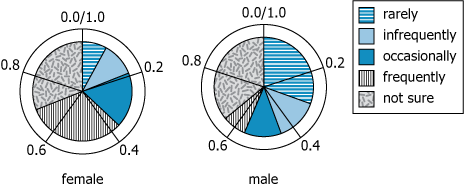The two charts show how female and male survey respondents answered a question about how often they ate a certain...
GMAT Graphics Interpretation : (GI) Questions

The two charts show how female and male survey respondents answered a question about how often they ate a certain type of food. The survey specified that "infrequently" meant more often than "rarely" but less often than "occasionally."
Select from the drop-down menus the options that create the statement that most accurately reflects the information provided.
Owning The Dataset
Table 1: Text Analysis
| Text Component | Literal Content | Simple Interpretation |
|---|---|---|
| Survey Subject | "how female and male survey respondents answered a question about how often they ate a certain type of food" | The dataset records how often men and women report eating a specific food. |
| Frequency Definition | "The survey specified that 'infrequently' meant more often than 'rarely' but less often than 'occasionally.'" | The key frequency options are in order: rarely < infrequently < occasionally. |
Table 2: Chart Analysis
| Chart Component | What's Shown | What This Tells Us |
|---|---|---|
| Chart Type | Two side-by-side polar pie charts (female on left, male on right) | Enables visual comparison of male and female survey responses. |
| Categories | rarely, infrequently, occasionally, frequently, not sure | Survey participants had five options to describe eating frequency, including uncertainty (not sure). |
| Gender Differences | Female: rarely 9.5%, infrequently 9.5%, occasionally 19%, frequently 31%, not sure 31% Male: rarely 32%, infrequently 12%, occasionally 12%, frequently 8%, not sure 36% |
Males more likely to report rarely/infrequently; females more distributed, with higher frequent consumption. |
| Not sure responses | Females: 31%, Males: 36% | Large percentages in both groups were unsure. |
Key Insights
- A much higher percentage of males (44%) say they eat the food 'at most infrequently' (rarely/infrequently) compared to females (19%).
- Female respondents are much more likely to report eating the food 'frequently' (31%) than males (8%).
- 'Not sure' is a common response in both groups (31% of females, 36% of males), suggesting possible uncertainty or unfamiliarity.
- Key gender difference: The most common response among females is 'frequently', while among males it is 'rarely' or 'not sure'.
Step-by-Step Solution
Question 1: Identifying the Proper Gender Group and Percentage
Complete Statement:
Slightly less than [BLANK 1] respondents indicated that they ate the food at most [BLANK 2].
Breaking Down the Statement
- Statement Breakdown 1:
- Key Phrase: Slightly less than
- Meaning: The actual value just falls below the threshold of the provided percentage option.
- Relation to Chart: Look for groups where the calculated proportion is just under an answer choice.
- Important Implications: Alignment between calculated percentages and answer options is crucial; the value must fall short of the given answer.
- Key Phrase: Slightly less than
- Statement Breakdown 2:
- Key Phrase: [BLANK 1] respondents
- Meaning: Refers to a quantifiable subgroup, specifically either male or female respondents at a certain percentage.
- Relation to Chart: Requires examining both male and female groups using chart data to find matching or nearly matching values.
- Important Implications: Calculation for both gender groups is necessary to identify which fits the condition best.
- Key Phrase: [BLANK 1] respondents
- What is needed: Which gender group has a cumulative percentage for certain frequencies that is just under one of the percentage options provided.
Solution:
- Condensed Solution Implementation:
Add the percentages for frequency levels 'rarely' and 'infrequently' for both genders, since 'at most infrequently' means combining those two. - Necessary Data points:
For females: rarely = 9.5%, infrequently = 9.5%; for males: rarely = 32%, infrequently = 12%.- Calculations Estimations:
Female: \(\mathrm{9.5\% + 9.5\% = 19\%}\); Male: \(\mathrm{32\% + 12\% = 44\%}\). - Comparison to Answer Choices:
19% (female) is slightly less than the 20% option; 44% (male) is slightly more than 40%. Therefore, '20% of the female' fits best.
- Calculations Estimations:
FINAL ANSWER Blank 1: 20% of the female
Question 2: Identifying the Correct Frequency Level
Complete Statement:
Slightly less than 20% of the female respondents indicated that they ate the food at most [BLANK 2].
Breaking Down the Statement
- Statement Breakdown 1:
- Key Phrase: at most [BLANK 2]
- Meaning: Cumulative frequency up to and including the given level (e.g., 'infrequently' means 'rarely' + 'infrequently').
- Relation to Chart: Sum all relevant female group percentages up to the frequency indicated.
- Key Phrase: at most [BLANK 2]
- What is needed: Which frequency level for females, when cumulative up to that level, gives a percentage just under 20%.
Solution:
- Condensed Solution Implementation:
Total the female percentages starting from 'rarely' and add next more frequent category to see what matches 'slightly less than 20%'. - Necessary Data points:
Rarely: 9.5%; Infrequently: 9.5%; Occasionally: 19%.- Calculations Estimations:
At most rarely = 9.5%; at most infrequently = \(\mathrm{9.5\% + 9.5\% = 19\%}\); at most occasionally = \(\mathrm{19\% + 19\% = 38\%}\). - Comparison to Answer Choices:
19% is just under 20% and results from combining rarely and infrequently, so 'Infrequently' is the correct fill.
- Calculations Estimations:
FINAL ANSWER Blank 2: Infrequently
Summary
By summing 'rarely' and 'infrequently' for females (\(\mathrm{9.5\% + 9.5\% = 19\%}\)), we see this is slightly less than 20%. Thus, '20% of the female' and 'infrequently' are the answers for the blanks in the statement.
Question Independence Analysis
The blanks are not independent: the correct choice for the first blank (gender and percentage) depends on which frequency level is chosen for the second blank, because the cumulative percentages differ by gender and frequency.